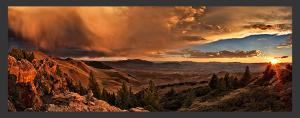Sale on canvas prints! Use code ABCXYZ at checkout for a special discount!

Knowing what to photograph by Leland Howard
Knowing what to photograph is like the process involved in other mediums. How does a painter know what to paint or how does the musician know what to play? Mostly it’s what moves you. Photographically if you care about the subject, it will show in the work.
Of course conditions, weather, and assignment contracts play a big role. If I’m not under a contract obligation, then experience that allows for hopefully maximizing opportunities comes into play. However, explaining the requirements for knowing where and what to photograph might perpetuate the common myth that once in a location, the tool (camera) does the work.
Take for example your cold winter day with a sky full of stars and sparkling snow. What can the artist create that will do this justice? Remember how you felt looking at that scene. Did you wonder if it was possible to create something, a piece of art, which would make a viewer feel something similar?
An artist may never do nature justice, but we can find some gratification in the challenge. Occasionally an image will be created that at least can be described as worthy.
I’m never completely satisfied with an image. If I were, this could show a point of stagnation and one thing an artist must do is continue to grow. I can say I accomplish what is necessary, especially when under contract, but otherwise the goal is never so concrete that would allow me to say that I accomplish what I set out to do. There are too many variables. Sometimes I’m able to create something better than what I was visualizing for an area simply because of conditions like the quality of the light or the balance of a scene. Other times (far too many) the opposite is true.
Here is something to think about. Instead of calling it taking pictures, try calling it creating an image or painting with light. You’re not taking anything and all you are recording is light - all we see is light. Objects, color, and contrast become apparent because of how light reacts with the elements in an environment.
I don’t always know where to go but educated guesses are very helpful. Since I specialize in the wilderness, seasons play a role. Then simple things can also help like topo maps. By studying the terrain on a map, I can often tell what areas would have the most potential in different light conditions. Also, I will often travel to the same area many times over to learn it and get a feel for when conditions might be right.
Having said this I can tell you it is also fun to just hit the road and see what I find. Many times I don’t where I will end up. This is a good feeling, I guess it’s freedom. I can burn sometimes and have to stop because of exhaustion in a place that’s nothing to write home about but I live for the times I come upon a spectacular place. I’ve seen some amazing things in my life and very often they’re not in the most famous places.